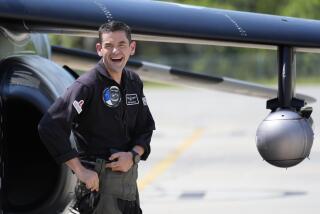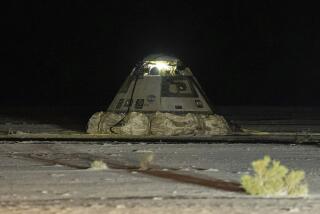NASA introduces astronaut crews chosen for the next human missions to launch from U.S. soil
Reporting from Houston — NASA on Friday announced the crews of the first spaceflights to be launched from U.S. soil since the space shuttle retired in 2011, an elite group of astronauts that the agency hopes will help open a new era of space travel.
The crews would fly on spacecraft developed not by NASA but by two corporations, SpaceX and Boeing, which are under contract to provide a taxi-like service to the International Space Station.
For the first human test flight of Boeing’s Starliner spacecraft, NASA selected astronauts Eric Boe and Nicole Mann to join Boeing executive Chris Ferguson. NASA astronauts Bob Behnken and Doug Hurley were chosen to fly on the first human test flight of SpaceX’s Dragon capsule.
On the first operational mission to the International Space Station, Sunita Williams and Josh Cassada would fly for Boeing, while NASA astronauts Victor Glover, a Southern California native, and Michael Hopkins would fly Dragon’s first operational mission to the space station.
“It’s absolutely an opportunity of a lifetime,” said Mann, who was selected as an astronaut in 2013.
“The first flight is something you dream about as a test pilot,” said Hurley, who flew on the last shuttle mission. He then added that it looked like the launch date was finally approaching, and that the mission would actually happen.
Hopkins, born in Pomona, is a graduate of Ontario High School and received his bachelor’s in engineering from Cal Poly San Luis Obispo.
In 2014, Boeing and SpaceX were awarded a combined $6.8 billion in contracts from NASA to develop spacecraft capable of flying crews to the station, the orbiting laboratory.
Leading up to the ceremony at the Johnson Space Center here, NASA Administrator Jim Bridenstine said it was a historic moment for the agency: “We are going to launch American astronauts from American soil. That’s a big deal.”
Both Boeing and SpaceX have faced setbacks and delays — with the latest schedule slips being announced on Thursday. While both companies had recently said they would conduct their first test flights with astronauts on board by the end of this year, those flights are now scheduled for 2019.
Gwynne Shotwell, the president of SpaceX, told the crews on Friday: “What a sacred honor this was to be part of this program and to fly you. Thank you. We take it very seriously. We won’t let you down.”
SpaceX said it would fly crews by April of next year. Boeing said only that it would fly NASA astronauts by the middle of next year.
Last week, Boeing confirmed that it had a problem with its launch-abort system, which is designed to ferry crews to safety in the event of an emergency. In a call with reporters this week, John Mulholland, Boeing’s program manager, said several valves failed to fully close, resulting in a propellant leak.
Boeing has since identified the problem, he said, and is working to fix it. “The result is that we’ll have a better and safer spacecraft,” he said.
SpaceX did not give a reason for the delay of its first crewed test flight. But it had been working to resolve an issue with its second stage that caused one of its Falcon 9 rockets to explode while it was being fueled ahead of an engine test.
“Safely and reliably flying commercial crew missions for NASA remains the highest priority for SpaceX,” Benji Reed, SpaceX’s director of crew mission management, said in a statement.
SpaceX, however, moved up the uncrewed test flight of its Dragon spacecraft from December to November of this year.
Since the shuttle was retired seven years ago, U.S. astronauts have had to fly on Russian rockets from a remote launch site in Kazakhstan.
In a recent report, the Government Accountability Office said that further delays in NASA’s “Commercial Crew” program could “disrupt access” to the space station, which would be an enormous embarrassment for NASA after about $100 billion was invested to build and operate it.
The report warned that the companies’ schedules are “aggressive” and that they “have set ambitious — rather than realistic — dates, only to frequently delay them.”
More to Read
Inside the business of entertainment
The Wide Shot brings you news, analysis and insights on everything from streaming wars to production — and what it all means for the future.
You may occasionally receive promotional content from the Los Angeles Times.










